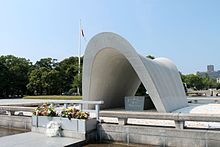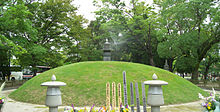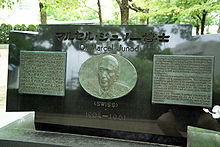Hiroshima Peace Park
The Hiroshima Peace Park ( Japanese 広 島 平和 記念 公園 Hiroshima Heiwa Kinen Kōen , actually Hiroshima Peace Memorial Park ) is a little more than 12 hectares of green space in the center of Hiroshima in Japan . The park is a place of remembrance with over 70 monuments, facilities, statuettes and memorial stones dedicated to the direct and indirect victims of the atomic bomb attack of August 6, 1945 .
History and description
The park was designed in accordance with the Hiroshima Peace Memorial City Construction Law of 1948 after the atomic bombs were dropped on Hiroshima and Nagasaki . The aim was to rebuild the Nakajima district , which was located on an island between the Motoyasu-gawa and Honkawa rivers and over which the atomic bomb had detonated, as a recreational area for the urban population after its complete destruction . At the same time, as a memorial , the park should offer the opportunity to mourn the victims and reflect on the effects of an atomic bomb , but it should also serve as a symbol of peace .
The park is laid out in such a way that the Peace Monument, the Peace Pond, the Peace Flame, the Cenotaph, the Peace Museum , the Fountain of Prayer, the Statue of Mother and Child in the Storm and, more recently, the Gates of Peace, all lie in the middle on a line Cenotaph forms the center. From the peace memorial there is a continuous line of sight in precisely that order.
Every year on August 6th, a peace ceremony is held in the park to mark the anniversary of the atomic bombing . During the celebrations, the incumbent Mayor of Hiroshima presented the declaration of peace , which appealed to all states around the world to abolish nuclear weapons and work for world peace . At 8:15 a.m., the time of the detonation, the peace bell rings in for a minute's silence. After nightfall, innumerable paper lanterns are lit and placed on the river and allowed to drift ( Tōrō nagashi ).
On May 28, 2016, Barack Obama became the first US President to visit Hiroshima Peace Park.
Monuments
Better known as the Atomic Bomb Dome ( A-bomb Dome ). The former building of the Chamber of Commerce and Industry from 1914 remained largely intact despite the short distance to ground zero of 160 m, as the pressure wave from the explosion acted almost perpendicularly on the structure. In 1996 the ruin was added to the UNESCO World Heritage List .
- Cenotaph for the victims of the atomic bomb
The monument to Hiroshima, the city of peace, was designed by Kenzō Tange in 1952 . The stone cenotaph contains a list of deceased victims of all nationalities, if the relatives so wish. The list is constantly being expanded (see Hibakusha ), on August 6, 2015 it comprised 108 volumes with 297,684 names. It is written on the stone: "Let all souls rest here in peace, for we will not repeat evil" .
- Flame of peace
The structure was designed by Kenzo Tange and shows two hands joined together that open upwards like a cup. An “eternal fire” burns in their midst, which has not been extinguished since August 1, 1964 and is supposed to burn until the day comes when all nuclear weapons have disappeared from the earth .
- National Peace Memorial Hall for the Atomic Bomb Victims
The building opened in 2002 to archive testimonials and memories from survivors and victims, and to give visitors a better understanding of how much suffering the atomic bomb caused the people of Hiroshima. In addition to a memorial hall, which invites to silent prayer, the portraits and names of all registered deceased Hiroshima atomic bomb victims are published on screens.
- Children's Peace Monument
The monument was erected in 1958 and dedicated to Sadako Sasaki , who died in 1955 at the age of 12 from the sequelae of radiation. She became known worldwide for folding hundreds of origami cranes ( orizuru ). After her death, this nine-meter-high bronze statue was created with the support of 3,100 schools inside and outside Japan. On the top of the three-legged dome stands the figure of a girl holding an origami crane. There is an inscription on the base: “This is our call. This is our prayer. For building peace in the world. ” Around the memorial there are showcases with thousands of paper cranes that have been threaded on and folded by children from all over the world as a symbol of the peace movement and resistance to nuclear war.
- Atomic Bomb Hill Monument
Here the remains of many victims were gathered and burned. A provisional monument was erected in May 1945 through donations from citizens, and a cinerarium and shrine were built in July of the same year . Ten years after the atomic bomb, in July 1955, the current hill was inaugurated with an underground cinerarium.
- Peace bell
The bell was donated in 1964 by the A-bomb Survivor Hiroshima Hope Fruition Society . A world without borders can be seen on the surface of the bell, at the point of impact there is an atomic symbol. The peace bell and its suspension are surrounded by a water basin with lotus flowers .
- Fountain of prayers
The fountain was donated in 1964 by the Hiroshima Bank and consists of a larger oval basin 27 m long and 19 m wide and a smaller fountain in the middle. Many of the victims, who did not die immediately, were thirsty from severe burns and cried for water until they died. The well is supposed to quench the thirst of these souls. In the foreground the "statue of mother and children in the storm". The bronze statue was created by Shin Hongo in 1960 and was funded by donations from the Hiroshima Municipal Federation of Women's Associations .
- Gates of peace
This monument consists of ten glass gates nine meters high, which are located at the southern end of the park along the Peace Boulevard. The word “peace” is engraved in 49 languages. The gates were donated by the French artist Clara Halter together with the French architect Jean-Michel Wilmotte to mark the 60th anniversary of the atomic bomb being dropped .
- Monument to the old Aioi Bridge
The bridge, which spanned north of the island to the Aioi-dori , survived the detonation and remained in operation for another 35 years before it was replaced by a newer construction.
- In memory of Doctor Marcel Junod
Junod came to Japan as a delegate of the International Committee of the Red Cross (ICRC). He put together a relief mission for the city, and on September 8, 1945, was the first foreign doctor to reach Hiroshima. During his five-day stay, he visited all the sick camps, supervised the distribution of relief supplies and provided medical help himself.
- Monument to the former Northern Tenjin-machi District
The stone was inaugurated in 1973. Tenjin-machi was considered the entertainment district of Nakajima. Since the area was completely destroyed by the explosion, it was not rebuilt. Instead, the Peace Park was built in its place.
- More monuments
- Monument to the former Tenjin-machi South District
- Hiroshima's Zero Mile Stone (see fundamental point )
- Monument to the former Zeimoku-cho district
- Hook lilies that survived the atomic bomb
- Linden tree monument
- Monument to the Volunteer Army Corps
- Second Middle School Monument
- Monument to the City Shipbuilding Industry School
- Memorial monument for the victims of the bombed municipal secondary school for girls
- Monument to the Employees of the Hiroshima Post Office
- Monument to the builders and craftsmen
- Monument to the employees of the Coal Control Related Company
- Monument to the Hiroshima Gas Corporation
- Monument to the atomic bomb victims of the Hiroshima Agricultural Association
- Monument to the Hiroshima district lamber control corporation
- Monument to Zensonpo ( All Japan Casualty Insurance Labor Union )
- Monument to Doctor Hideki Yukawa: Statue of Peace New Leafs
- Monument in memory of Norman Cousins
- Monument commemorating Pope John Paul II and his appeal for peace
- Monument to the poet Sankichi Toge
- The Barbara Reynolds Memorial Monument
- Flower clock
- Cedar of Peace
- Memorial tower for the atomic bomb victims
- Stone Lantern of Peace
- Atomic bomb tombstones
- Fountain of peace
- Figure of the merciful goddess Kannon of peace
- Night watch lamp
- Mother of Mercy statue
- Friendship Monument
- Watch to commemorate the repatriation of those who have chosen to return to the Democratic People's Republic of Korea
- Peace memorial mailbox
- Prayer monument for peace
- Prayer Haiku Monument for Peace
- Hair monument
- The Ground Zero , that is the ground zero on the atomic bomb is detonated, is outside the Peace Park across the Motoyasu River, about 200 meters east of the peace monument in front of the Shima Hospital.
Monument to the Korean victims and survivors
Phoenix trees that survived the atomic bomb
Merciful, comforting goddess Kannon for the mobilized and killed students
Web links
- Map with the locations of the monuments (PDF) Website of the city of Hiroshima (English)
- Virtual tour of the Peace Park with more information about the monuments . Hiroshima City Website
- Hiroshima Peace Park . Japan-Experience.de, July 24, 2017
Individual evidence
Coordinates: 34 ° 23 ′ 34 ″ N , 132 ° 27 ′ 9 ″ E























